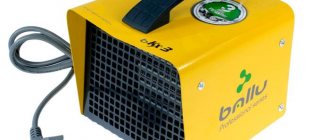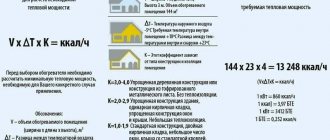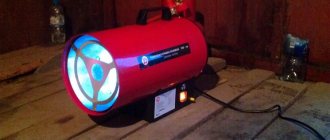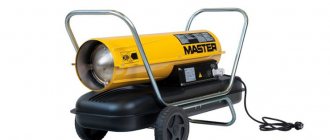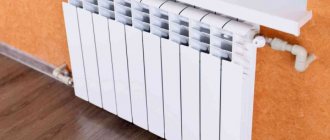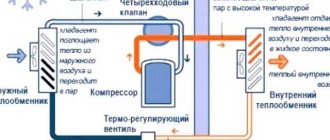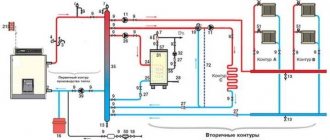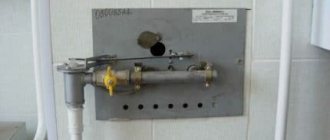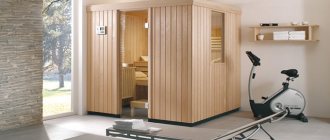What is a heat gun
The demand for such a modern unit increases significantly during the heating season, provided there is no central heating or its supply is of poor quality. Gas heating guns emit warm air, which is formed by burning gas. Externally, it is a streamlined metal body with a hole for the hot flow to escape, but inside the design is somewhat complicated and is represented by the following elements:
- burner;
- fan;
- heat exchanger;
- ignition device;
- control device;
- thermostat;
- additional devices depending on the design features.
Types of gas guns
Before making the final choice, it is important to find out what types of designs exist and which option is optimal in a particular case. The gas heat gun is very popular; it is necessary for heating and ventilating residential premises and drying large objects. The range is wide, but the classification provides only two design features - direct and indirect heating. Both options are suitable for household needs, but have different appearance and operating principles.
Direct heating
In this design, air flows are not purified from burning, so they all collect in the living room and poison oxygen. Directly heated gas guns are needed where there is sufficient natural or artificial ventilation. This is the main disadvantage of the gun, but significant advantages remain 100% efficiency, minimal energy and fuel consumption.
Indirect heating
The ring heat exchanger acts as the main heating element, which operates on the following principle: first the gas is burned, then the toxic products that are released during the formation of the fuel. An indirectly heated gas heat gun is an environmentally friendly device, so its installation indoors is possible even with limited ventilation. The disadvantage of the mechanism is the presence of a chimney, which complicates the mobility and transportation of a gas-type gun.
Gas heat generators ballu
-
- This is a fairly powerful fan heater running on propane-butane gas. The device is designed for rapid local heating of residential and domestic premises, directed by a heated air flow. The power of this device is 9.2 kW. The device is equipped with an axial fan with a capacity of 300 m3/hour. The fan is powered from a 220V household power supply. Gas consumption is 0.7 kg/hour.
Ballu BGH-10This climate control device is equipped with a multi-level protection system that stops the gas supply when the fuel supply runs out, there are interruptions in operation, or the flame suddenly goes out. In addition, the manufacturer has equipped this heat generator with a convenient piezo ignition, reinforced with a gas hose with a reducer installed on it.
The Ballu BGH-10 case is made of steel with an anti-corrosion coating, which makes it indispensable for use in conditions of high humidity. The fuel combustion chamber is made of galvanized steel. The weight of the model is 6.3 kg.
The average cost in retail stores in Russia is 165 USD.
- Gas heat gun Ballu BGH-40. This model is not much different from the previous one. The differences are: increased efficiency, which is close to 100%, the power of the device is 36.7 kW, the consumption of liquefied gas Ballu BGH - 40 is 2.2 kg/hour.
In addition, this heat gun model has a more powerful axial fan with a capacity of 1000 m3/hour, a magnetic valve made of heat-resistant steel, which prevents ignition of the gas in the internal part of the burner at low pressure.
The automation of this device is equipped with a protective thermocouple and a bimetallic fuse. The weight of the device is 7.8 kg, and the cost in domestic specialized retail stores varies from 250 USD. up to 310 USD
-
– this is the most powerful direct-heating gas heat gun of the entire line presented by the manufacturer, which is perfect for heating air in fairly large industrial and residential premises. The maximum power of the device is 73.4 kW, and the fan capacity is 2300 m3/hour.
Ballu BGH-85This heat gun contains all the innovative solutions for which this brand’s climate control equipment is famous. This includes a high-quality metal housing with a polymer coating and a galvanized combustion chamber, a multi-level protection system, and the latest automation, which stops the fuel supply when the gas pressure drops and there is no voltage in the network.
Gas consumption at maximum operating mode is 4.4 l/h. Device weight 13.5 kg. Its cost in domestic retail stores varies from 480 USD. up to 550 USD
According to experts, Ballu BGH-85 is the best device released under this brand.
How does it work
Before using a gun at home, you need to understand in detail how it is designed, how it functions correctly, and which manufacturer is the best in a given direction. This significantly facilitates the final selection of a suitable design and simplifies the operation process. The operating principle of a gas gun is as follows:
- The combustion chamber contains a special burner into which a gas flow is supplied.
- Using the ignition device, the gas burns and the heat exchanger heats up.
- The fan draws in cold air from the environment and directs it through the heat exchanger.
- A thermostat specially integrated into the circuit protects the unit from overheating and breakdown.
- The presence of a switch breaks the electrical circuit when the room is heated to the desired value on the thermometer.
Pros and cons of gas heat guns
Existing advantages:
• Quick heating of enclosed spaces. • Available fuel. • No odor. • Mobility of many thermal installations of this type.
Existing disadvantages:
• They burn oxygen, especially models with direct heating. • Significant gas consumption, which reduces the operating time of the gun; large gas cylinders are desirable. • Cold gas cylinders burn poorly and heating time may increase. • If you use small cylinders and there is less than half of the gas left, then the burner may not burn well; here, it is also recommended to use large cylinders to correct the situation. • Some models make a lot of noise. • A source of electricity is required to operate the fan since all fuel is used only for combustion and heat generation.
Gas gun device
Such a home heater is used for domestic needs, and the preference of modern buyers is given to mobile types of gas “burner” with wheels and control knobs. Stationary guns are equipped with a gas cylinder, which is problematic to transport. The duration of operation of the unit itself and its technical characteristics depend on its volume. This stationary design of an indirect blow gas gun is considered obsolete and impractical to use; mobile models in the range are more in demand.
Gas heat gun
This is an independent heating device and a structural component of a heating installation, necessary to maintain the necessary climatic conditions in a residential area and beyond. A natural gas heat gun can be used to heat automobiles and special equipment, and is useful during repairs and for installing suspended ceilings. The presence of a fan allows you to speed up the technological process, and the built-in thermostat controls the heating of the air flow. The gun operates on gas; a suitable model can be ordered in the online store.
Propane gun
It is also called a loudspeaker because you can hear a loud bang during operation. If the previous model operates on gas, then this unit has its own design features. A propane heat gun is an environmentally friendly device and is often used to scare away birds and wild animals. Among the advantages, experts highlight simplicity of design, lightness and efficiency.
Making a gas heat gun with your own hands
various models on sale , but many home craftsmen construct such devices on their own. There are no particular difficulties in the design of a gas gun.
To make such a heating device, you need to understand the principle of its operation, have skills in working with welding equipment and take care of the availability of the necessary materials,
Since most home craftsmen plan to use a home-made heat gun to heat garages, they choose the design of an indirectly heated gas gun connected to the chimney . This design allows you to be in a heated room during its operation.
To create a gas gun you will need the following materials :
- a pipe 1 meter long, 180 mm in diameter, intended for the manufacture of the body;
- a pipe of the same length, but with a diameter of 80 mm for the combustion chamber;
- a pipe 0.3 meters long, 80 mm in diameter for the heated air outlet pipe;
- gas burner equipped with piezo ignition;
- any axial fan with a round flange.
the schematic diagram of a gas heat gun below.
Assembly of a homemade gas gun equipped with a combustion chamber is carried out in the following order:
- Two holes are drilled on opposite sides of a larger diameter pipe. One of them, intended for welding the heated air outlet pipe, must have a diameter of 80 mm. The second hole is drilled with a diameter of 10 mm. It will include a gas hose connected to the burner.
- The combustion chamber is made from a pipe of smaller diameter. To firmly attach it to the pipe, it is necessary to weld plates that hold the structure in the center of the body.
- Then you need to prepare a plug cut from a metal sheet so that it closes the gap between the combustion chamber and the housing. In this case, access to the chamber must be provided to connect it to the chimney.
- The next step will be to assemble the structure. The fins of the combustion chamber must be welded inside the housing, and a pipe must be welded from the outside of its part, through which heated air and a plug will flow into the room. Then the gas burner is installed and firmly fixed, and the fan is mounted.
Assembling a gas gun with direct heating is much simpler, since it consists of a pipe, at one end of which only a burner and a fan are attached. Hot air along with combustion products exits from the opposite side of the pipe.
Application
Such gas-powered equipment is in demand in everyday life and in production and has found widespread use among the masses. This is not only quick heating of residential and non-residential premises, but also drying of individual items for automotive and industrial purposes. In addition, the use of a gas gun is appropriate for large areas - from 25 square meters. meters, during repair work, for example, when installing suspended ceilings.
For garage
These non-residential premises are characterized by dampness, which only hinders the storage and safety of a personal vehicle. To dry the walls and remove fungus from the far corners, it is recommended to use gas guns for the garage. The purchase is not cheap, but the unit can additionally be used at home and in the country. It is important to take into account such parameters as the size of the garage, the quality of thermal insulation, and the presence of people in such non-residential premises. There are two options for choosing guns:
- A gas gun can be used when there are no people in the room. The unit provides high operating power, fast heating of the garage, and minimal energy costs.
- A diesel gun is appropriate if people are or live in the garage. Thanks to the presence of an exhaust pipe, combustion products are efficiently removed and do not settle on the walls.
For heating residential premises
Considering the comparative characteristics described above, it becomes obvious that stationary direct airflow structures are not suitable for heating the specified space. A gas heat gun for residential premises must be equipped with an exhaust pipe so that combustion products do not linger in the living room. In addition, it is important to obtain high efficiency with minimal energy consumption.
For suspended ceilings
When carrying out repair work, this unit is also necessary. A gas heat gun for installing suspended ceilings is an indispensable “tool” because when PVC film is heated to 65 degrees over the entire surface, it becomes elastic and pliable. The material easily lies on the ceiling and is firmly attached to pre-prepared gaps. If the gas gun is turned on when performing this type of work, condensation does not accumulate on the base plate while attaching the PVC film. This is one of the important advantages of the participation of the mechanism during repair work.
Areas of application
The most effective is the use of gas heat guns when performing the following production operations:
- Heating of premises. The use of a heat gun in this case allows you to quickly and efficiently heat a living space, various outbuildings, as well as industrial premises with a large area.
- Ventilation of premises. If you turn off the gas supply to the unit, the heat gun will become a powerful fan, which will greatly promote air circulation in the room.
- Heating of surfaces and individual objects. The point directionality of the air flow of heat guns allows, for example, their effective use when drying newly plastered surfaces.
The use of gas heat guns when installing suspended ceilings is also considered indispensable. This is due, first of all, to the fact that the ceiling material becomes more plastic when it heats up quickly.
You may also be interested in the article about Master heat guns. Read an interesting article about Ballu brand heat guns here.
How to use a gas gun
If a person is superficially aware of how to turn on and off the specified mechanism, this does not mean that he is perfectly familiar with the use of heat guns. The principle of operation and operating rules can be studied in the instructions; if necessary, use the help of a specialist. When using a stationary gun, the following rules must be observed:
- Avoid the presence of flammable substances in the room to avoid their ignition.
- Ensure unhindered access of oxygen, due to which the gas gun actively supports the combustion process.
- It is forbidden to block the outlet or turn on the fan.
- Since air must circulate and not accumulate in the heat gun, it is necessary to install the unit in an open area to prevent clogging of the outlets.
- Supply gas if the gas gun is not broken and is working properly.
- Turn on the ignition button until the piezoelectric element or piezo ignition is activated.
- To prevent fuel leakage, it would be advisable to additionally introduce a fuse into the circuit.
- You should not save on fuel, otherwise the gas heat gun may very soon fail.
- Thai chicken salad is warm. Thai chicken salad recipe with photo
- Baked red fish in the oven
- Pityriasis versicolor in humans, causes, photos. Treatment of pityriasis versicolor with drugs and folk remedies
How to choose a gas heat gun
The most difficult thing is to make a choice, since the catalogs contain a huge number of interesting design items with unique technical characteristics. In order to buy a gas gun and not make a mistake, it is important to compare with electric and diesel designs. Some people prefer electric guns, where the main heating element is a heating element or a cylindrical spiral. However, it is important to understand the uneconomical nature of such a purchase for the future. Below are rated gas guns that have proven their effectiveness and cost-effectiveness of use.
Manufacturer
Ballu Industrial Group brand products are professional heat generators that do not require installation. All guns are mobile, and with the help of a special handle they can be easily and quickly transported. Photos of such cylindrical models can be found on numerous websites on the Internet, but before purchasing, measure the area of the heated room and do not save on such an important purchase. Below are a few guns that were of particular interest to buyers:
- model name – Ballu BHG-10;
- price – 4,800 rubles;
- characteristics - heating power 10 kW, direct heating method, heating area - 100 square meters, fuel - propane, operation at 220 V;
- advantages - compact size, 0.7-0.8 kg/h, ease of use, accessible operating instructions;
- There are no cons.
The second model of the same manufacturer, no less popular among the masses, is presented below:
- model name – Ballu BHG-40;
- price – 6,800 rubles;
- characteristics - overall Bally model with a heating power of 33 kW, ignition system - piezoelectric element, fuel - gas, consumption - up to 3.3 kg/h;
- pluses - the gas gun covers more space for heating than its predecessor, operates in an economical mode;
- cons – high price.
Gas heat gun shape
The models presented below are from different manufacturers, but have an identical cylindrical shape. Such heat guns are especially convenient for everyday use, are easy to transport, and do not take up much space. The original design does not interfere with the performance of basic functions; the main thing is not to clutter the outlets. Here are some great deals for your household needs:
- model name – Elitech TP 10GB;
- price – 4,200 rubles;
- characteristics - dimensions - 440x290x186 mm, fuel - propane, butane, designed for heating small areas, manual power adjustment at a maximum of 10 kV;
- advantages - quick heating of the room, absence of toxic fumes, affordable pricing;
- There are no cons.
The second gas gun is also in noticeable demand, but in terms of parameters it is a more powerful unit, therefore the electricity consumption is somewhat higher. This:
- model name – FUBAG Bruce 30;
- price – 7,300 rubles;
- characteristics - dimensions - 645x375x510 mm, maximum power - 30 kW, weight - 11 kg, cylindrical shape;
- advantages - ease of use, the ability to quickly heat up the room, compact size and streamlined shape, flame control function;
- cons – high price.
Heating method
Indirectly heated gas guns are more often purchased because one of the advantages is environmentally friendly operation and the absence of toxic combustion products in the air. Direct heating positions are also in demand, but they are purchased in the presence of high-quality ventilation and in the case of an unhindered supply of oxygen in unlimited quantities. Here are interesting offers for household needs:
- model name – Pegas PG 150;
- price – 4,200 rubles;
- characteristics - power - 15 kW, room volume - 300 square meters, gas - propane, butane, piezo ignition, fuel consumption - 1.1 kg/h, mains power - 220 Volts, indirect heating;
- advantages - the presence of instructions for use and a drawing in the package, fast heating of the air, energy savings;
- There are no cons.
The second indirect heating gas gun and its brief technical characteristics are presented below:
- model name – Prorab EH 2 R;
- price – 4,400 rubles;
- characteristics - power - 2 kW, weight - 4 kg, rectangular shape, air flow is 184 cubic meters / h;
- pros - an excellent model for repairs and household needs at an affordable price;
- There are no cons.
Power
This is a determining criterion for selection, on which the rate of heating of the room and energy consumption depend. For domestic purposes, 10 kW is enough, but for large areas it is better to pay attention to the maximum power limit of 30 kW. Here are two proposals that are considered “hot” on the domestic market:
- model name – Sial KID 10 20821017;
- price – 4,300 rubles;
- characteristics - indirect heating, gas - propane or butane, power - 10 kW, cylindrical gun, no electronic sensors;
- pros - convenient and reliable gas gun at an affordable price with good technical characteristics;
- There are no cons.
A competitor in terms of power is the following products from a domestic manufacturer of gas guns:
- model name – Bison Master 10;
- price – 4,500 rubles;
- characteristics – power – 10 kW, fuel consumption – 0.75 kg/h, runs on gas (propane, butane);
- advantages - fast and free delivery of Zubr MASTER in Moscow, affordable price, high technical performance;
- cons – customer reviews are not always positive.
Heating area
Many buyers choose a gas gun based on the heating area, and to do this, the first thing they do is measure the room. This is a mandatory condition, otherwise the purchase will end up being completely useless. Gas structures on sale are standard, so all that remains is to decide on the company and your final choice. So:
- model name – REDVERG RD-GH30;
- price – 5,600 rubles;
- characteristics – power – 30 kW, presence of an overheating sensor, flame control, heating area – 300 square meters;
- pros – covers large spaces, affordable price;
- disadvantages – the need for artificial ventilation.
Here is the second gas gun, which has a shorter range, but is also characterized by rapid heating and minimal energy consumption:
- model name – Caliber TPG-15;
- price – 4,400 rubles;
- characteristics - heating area - 110 square meters, power - 15 kW, floor-mounted installation, weight - 6 kg;
- pros - compact model at an affordable price with high technical characteristics;
- cons - the gun is used for warehouses with forced ventilation.
Gas gun dimensions
For individual buyers, the dimensions of the structure are important so that the unit does not take up much space in the room and does not turn out to be unnecessarily bulky. The parameters are standard for household purposes, but there are more compact options for convenient storage. This:
- model name – Profteplo KG-18 4110800;
- price – 5,200 rubles;
- characteristics - dimensions 470x225x397, weight - 6.6 kg, power - 18 kW, metal case, gas operating principle;
- advantages - lightweight, comfortable, compact, inexpensive design with high technical performance;
- There are no cons.
An example of another compact gas gun is presented below:
- model name – Neoclima NPG-10;
- price – 3800 rubles;
- characteristics - dimensions - 394x200x390mm, weight - 5.6 kg, direct heating type;
- advantages - low price, minimal fuel consumption, convenient home use;
- cons - more often used in small spaces - in warehouses, garages.
Choosing the right heat gun
Having come to the idea that you need to purchase a heat gun, you immediately find yourself faced with the question: “How to choose it?” The answer is simple. It is necessary to rely on such criteria as the volume of the room, the number of people present there, and what type of fuel will be used, since most of the modern guns begin to function on gas, diesel and electricity. To calculate the thermal power required for your room, a simple formula was invented: V x T x K = kcal/h. One kilowatt is equivalent to 860 kilocalories per hour.
- V is the volume of the room that needs to be heated;
- T is the temperature difference;
- K is the dissipation coefficient, depending on the type of construction of the house and its degree of insulation.
But you shouldn’t trust the formula entirely, since circumstances play a decisive role. That is, the number of window openings in the house, the number of doors located and, of course, the height of the ceiling.
The heat gun market is constantly moving, expanding, something new appears, but in general, if we summarize, we can distinguish three types: electric, gas and diesel guns. Each existing type of gun has its own advantages and disadvantages.
Video explanation for calculating the power of a heat gun:
Electric guns
When there are no problems with electricity in the room, then electric guns are a good option, they are the most affordable and easy to use.
On what principle do these heat guns work? Of course, from the network. If the gun model has a power of up to 5 kTv, then it is powered from a 220 volt network; if the gun is more powerful, then a 380 volt network is required. Their mobility, ease of use, and the absence of the need to use other fuels have brought them well-deserved popularity, both in everyday life and in construction.
The heat is distributed throughout the room due to the fact that the fan blows it and distributes it evenly throughout the room.
Gas guns
Gas guns have two undeniable advantages - low price and light weight of the models. Their power varies from 10 to 100 kTV, although there are more. Gas guns operate on gas, which is supplied through a cylinder reducer or thanks to a centralized gas network. When the gas burns, the heat exchanger heats up. The air passing along the heat exchanger is also heated, thus creating heat in the room.
Gas guns are very economical, but there is still a drawback. Liquefied gas in cylinders cannot be purchased everywhere, and it is difficult to stock up due to a number of storage requirements.
Diesel guns
Diesel guns run on fuel such as diesel fuel and have a common operating principle with gas guns, although their design is more complex.
Among the advantages of guns, it is worth noting their remarkable cost-effectiveness. By filling the gun once with diesel fuel, you can be provided with continuous 10-15 hour operation of the equipment. Delivery of diesel fuel is safe and is not connected to the gas main. Well, the power of diesel guns is not inferior to gas guns.
The disadvantages of diesel guns are their heavy weight and the fuel, which contains contaminants. Because of the last point, they should be used in non-residential premises where there is good ventilation.
Heat guns for direct and indirect heating
Speaking about diesel guns, it is worth noting that they are divided into two types: direct and indirect heating.
This means that a direct heating heat gun evaporates all combustion products directly into the air. Accordingly, it would be advisable to use a direct heating diesel gun in open areas, such as construction sites, or in non-residential premises. An indirect heating heat gun has a special exhaust system for combustion products, which means it can be used to warm up unventilated rooms.
